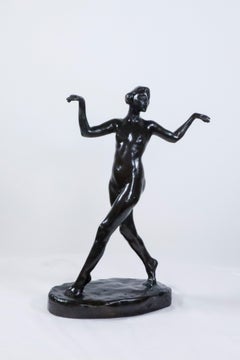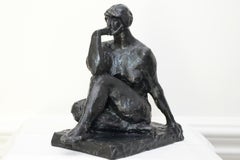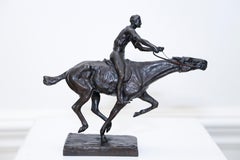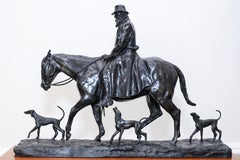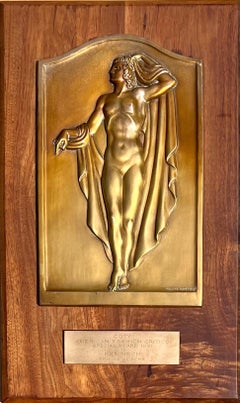Charles Cary Rumsey Art
American, 1879-1922
CHARLES CARY RUMSEY, born in Buffalo, NY in 1879. His interest in sculpture appeared and was encouraged at an early age as he was considered a prodigy his parent sent him to Paris to study art in 1893.
Graduated Harvard in 1902, Rumsey returned to Paris where he took a studio in the Latin Quarter and enrolled and the Julian and Colarossi Academies. One professor, Emmanuel Fremiet, a specialist in equestrian statuary, and his training was to have a decisive influence on the young Rumsey. Rumsey was a superb rider and a world-class polo player.
His large monuments remain in locations around the world.
Beaux Arts Museum Paris France Brooklyn Museum of Art, Brooklyn NY Metropolitan Museum of Art, New York
Museum of Modern Art, New York
Nassau County Museum of Art, Nassau Co.NY
Newark Museum of Art, New Jersey
Whitney Museum of Art, NY
Pan American Exposition Buffalo 1901
National Sculpture Society Exhibition under the Auspices of the Municipal Art Society of Baltimore,
Fifth Regiment Armory Baltimore, 1908
Architectural League of NY 24th Exhibition 1909 Architectural League of NY 27th Exhibition 1912
MacBeth Galleries NY “A Collection of Small Bronzes by American Sculptors” 1912
1913 Armory Show, NY, Art Institute of Chicago 1913
National Sculpture Society 1913
Kingore Gallery Exhibition NY 1913
Architectural league of NY 28th Exhibition
Albright Art Gallery, Buffalo NY “An exhibition of works by Buffalo Artists” 1914
Panama Pacific International exhibition, San Francisco, California 1915
Fine Arts Institute , Kansas City Missouri 1916
Sculptors Gallery, “Exhibition of sculptures by Charles Cary Rumsey” Art Association of Indianapolis Metropolitan Museum of Art, NY 1918
American Painting and Sculpture, Pertaining to the War” Knoedlers, NY 1918-1919
Albright Art Gallery, Buffalo, 1919
Art Institute of Chicago 1920
Metropolitan Museum of Art NY, 1921
Carnegie Institute Exhibition Architectural league of NY 28th Annual Exhibition, Metropolitan Museum of Art, NY 1923
National Sculpture Society, NY 1923
Exposition Retrospective de L’ourvre “Charles Cary Rumsey” Societe’ Nationale des Beaux-Arts, Paris, 1927
Brooklyn Museum NY 1930
Whitney Museum of Art NY 1932
American Sculpture and Paintings, Museum of Modern Art NY 1932-1933
Century of Progress, Exhibition of Paintings and Sculpture, The Art Institute of Chicago, 1933
The Centennial Exhibition, Department of Fine Arts Dallas Museum of Fine Arts, Texas, 1936
Three Centuries of American Art, Organized by the Museum of Modern Art NY Muse’ du Jeu de Paume, Paris 1938
Sport in Art, Albright Art Gallery, Buffalo NY 1948
A Survey of American Sculpture, late 18th century to 1962, Newark Museum of Art New Jersey. 1962
National Art Museum of Sport Premier Exhibition, Madison Square Garden Center, NY 1968
Horse in America, Monmouth Museum, Red Bank New Jersey 1970
American Art in the Newark Museum, 1981
Dog Museum of America, NY 1983
The Shock of Modernism in America Nassau County Museum of Art 1984
Sporting Art, Anderson Galleries, NY 1986
Sporting Art, Anderson Galleries NY, 1988
Polo in America, American Cup Polo Tournament, Meadowbrook Polo Club NY(Biography provided by Lynda Anderson Galleries)
to
9
7
2
Overall Height
to
Overall Width
to
3
1
1
7
7
6
2
2
2
2
2
2
1
1
1
1
1
1
1
1
9
8
1
9
6,996
3,348
2,513
1,213
9
9
Artist: Charles Cary Rumsey
Dancing Nude Bronze of a Woman "Femme Dansant, 1910"
By Charles Cary Rumsey
Located in Brookville, NY
Dancing Nude Bronze by Charles Rumsey is one of many figures he depicted of women. He has usually been known for his sculptures of horses, polo players, wildlife and dogs, mainly due to the fact that he was an avid sportman, hunter, and renowned polo player. However, he often depicted women in flattering if not loving ways. Often in movement, sometimes in reflection, in small sizes such as this one of Dancing Nude and also in large outdoor sculptures...
Category
1910s Charles Cary Rumsey Art
Materials
Bronze
Rams Head Sculpture in Bronze by Charles Rumsey
By Charles Cary Rumsey
Located in Brookville, NY
Charles Rumsey was an avid sportsman, horseman and a child prodigy in sculpting sent to Paris to study as a boy. His life of hunting fishing and ridin...
Category
1910s American Realist Charles Cary Rumsey Art
Materials
Bronze
Woman Seated A Bronze Sculpture of a Woman by Charles Rumsey
By Charles Cary Rumsey
Located in Brookville, NY
The bronze sculpture of a woman by Charles Rumsey is undated, but was created at a point in his career where he began to transition from realism to more modern, looser depictions of ...
Category
1920s American Modern Charles Cary Rumsey Art
Materials
Bronze
Winning the Race Galloping Horse and Rider in Bronze by Charles Rumsey
By Charles Cary Rumsey
Located in Brookville, NY
Rumsey’s specialties included equestrian sculptures – portraits of polo players and prize horses, as well as of cowboys, cattle and horses as metaphors. He worked principally in bron...
Category
1910s American Impressionist Charles Cary Rumsey Art
Materials
Bronze
The Old Virginian, Bronze of a Horse and Rider with Dogs by Charles Rumsey
By Charles Cary Rumsey
Located in Brookville, NY
From the estate of the Artist Charles Cary Rumsey
The Artist, Charles Rumsey, was a child prodigy sent to Paris as a young boy to study sculpture. He later was a world class sports...
Category
1910s American Impressionist Charles Cary Rumsey Art
Materials
Bronze
Dog Bronze Foxhound Sculpture by Charles Rumsey
By Charles Cary Rumsey
Located in Brookville, NY
This beautiful bronze of a Foxhound is a study for what was to be a pair of larger ones used as a pair of Andirons outside fireplace at Harriman House in NYC. The artist, Charles Ru...
Category
1910s American Realist Charles Cary Rumsey Art
Materials
Bronze
Sculpture of a Polo Player Harrison Tweed by Charles Rumsey
By Charles Cary Rumsey
Located in Brookville, NY
Polo Pony and Rider Harrison Tweed . Charles Rumsey was an 8 goal polo player with Meadowbrook Polo Club on Long Island NY. He was an avid sportsman, equestrian and artist. His ab...
Category
1910s Abstract Impressionist Charles Cary Rumsey Art
Materials
Bronze
Jockey Pipe Rack in Bronze A Bronze by Charles Rumsey
By Charles Cary Rumsey
Located in Brookville, NY
Charles Rumsey was a child prodigy sent to Paris to train in sculpting at age 12. He was not only a prodigy sculptor but an avid horseman and sportsman...
Category
1910s American Impressionist Charles Cary Rumsey Art
Materials
Bronze
Buffalo or Bison in bronze by Charles Rumsey
By Charles Cary Rumsey
Located in Brookville, NY
Buffalo Cow by Charles Rumsey, a bronze sculpture that dates C.1910 and may be part of the preparation for the Manhattan Brie Frieze executed in 1916. ...
Category
1910s American Realist Charles Cary Rumsey Art
Materials
Bronze
Related Items
Volo Standing Male Nude Sculpture Figure Bronze Boy - In Stock
By Wim van der Kant
Located in Utrecht, NL
Volo Standing Male Nude Sculpture Figure Bronze Boy - In Stock
Volo is a standing male nude figure in bronze, a boy reaching, in brown patina. This sculpture is suitable for indoors ...
Category
21st Century and Contemporary Contemporary Charles Cary Rumsey Art
Materials
Bronze
Free Shipping
H 15.75 in W 3.94 in
1961 Coty Award Plaque Kenneth Hairdresser Jacqueline Onassis Bronze Fashion
Located in New York, NY
1961 Coty Award Plaque Kenneth Hairdresser Jacqueline Onassis Bronze Fashion
Bronze on wood. The wood plaque measures 12 3/4" by 20 3/4 inches. The bronze plaque itself is 13 3/4 x 8 3/4 inches and the the bronze inscription, which reads "COTY, American Fashion Critics Special Award 1961 to KENNETH of LILY DACHE...
Category
1960s American Modern Charles Cary Rumsey Art
Materials
Bronze
Ian Edwards - Creation of Self - Original Signed Bronze Sculpure
By Ian Edwards
Located in Collonge Bellerive, Geneve, CH
Ian Edwards - Born of Fire - Original Signed Bronze Sculpure
Dimensions: 30 x 32 x 32 cm
Edition of 12
Edwards’ practice expresses the power and determination of human endeavour. He
draws inspiration from natural forces, with his powerful masculine figures often
bearing the surface texture of time enduring landscapes. Edwards uses this external
inspiration to explore very internal themes of fortitude and self-discovery.
Edwards’ sensitive hand as a sculptor incorporates classical ideas about the
sculpting process. In both Self Made Man and Creation of Self...
Category
2010s Contemporary Charles Cary Rumsey Art
Materials
Bronze
H 11.82 in W 12.6 in D 12.6 in
Elsie (7/25) - One-of-a-kind Bronze Sculpture
By Nando Kallweit
Located in Los Angeles, CA
German sculptor Nando Kallweit produces figurative bronze sculptures and reliefs with aquiline and a graceful modern appeal. Kallweit is inspired by seemingly disparate cultures; the...
Category
21st Century and Contemporary Abstract Charles Cary Rumsey Art
Materials
Metal, Bronze
Gallulus Bronze Sculpture Nude Boy Male Figure Green Patina Marble Stone
By Wim van der Kant
Located in Utrecht, NL
Gallulus Bronze Sculpture Nude Boy Male Figure Green Patina Marble Stone
Wim van der Kant (1949, Kampen) is a selftaught artist. Next to his busy profess...
Category
21st Century and Contemporary Contemporary Charles Cary Rumsey Art
Materials
Marble, Bronze
Free Shipping
H 16.54 in W 7.88 in
Harmony, 20th century bronze & green marble base, nude man and woman with lyre
By Max Kalish
Located in Beachwood, OH
Max Kalish (American, 1891-1945)
Harmony, c. 1930
Bronze with green marble base
Incised signature on right upper side of base
14 x 9 x 5 inches, excluding base
17 x 10 x 8 inches, including base
Born in Poland March 1, 1891, figurative sculptor Max Kalish came to the United States in 1894, his family settling in Ohio. A talented youth, Kalish enrolled at the Cleveland Institute of Art as a fifteen-year-old, receiving a first-place award for modeling the figure during studies with Herman Matzen. Kalish went to New York City following graduation, studying with Isidore Konti...
Category
1930s American Modern Charles Cary Rumsey Art
Materials
Marble, Bronze
The Guardian by Nando Kallweit 167cm Elegant bronze sculpture of human figure
By Nando Kallweit
Located in Coltishall, GB
The Guardian by Nando Kallweit bronze sculpture, edition of 13
Dimensions: 167cm tall
Category
21st Century and Contemporary Charles Cary Rumsey Art
Materials
Bronze
H 65.75 in W 11.82 in D 11.03 in
"Untitled" bronze sculpture of seated female figure by artist Felipe Castañeda
By Felipe Castañeda
Located in Boca Raton, FL
"Untitled" bronze sculpture of a female nude by artist Felipe Castañeda. Inscribed F. Castañeda 1984 P/A on base.
Category
1980s Modern Charles Cary Rumsey Art
Materials
Bronze
Satyr with Cymbals and Kroupezion, Grand Tour after the Antique, 19th century
Located in Beachwood, OH
19TH CENTURY CONTINENTAL SCHOOL
Satyr with Cymbals and Kroupezion, Grand Tour after the Antique
Bronze with marble base
26 in. h. x 15 in. w. x 10 in. d.
This dancing faun is now mo...
Category
19th Century Charles Cary Rumsey Art
Materials
Marble, Bronze
H 26 in W 15 in D 10 in
Nude Female Torso Bronze Sculpture, 20th Century Contemporary American Artist
Located in Beachwood, OH
Alan Cottrill (American, Ohio, b. 1952)
Nude Female Torso, 1994
Bronze mounted to green marble base
Signed, dated and numbered 14/20 verso of leg, with foundry stamp
17. in. h. x 6 i...
Category
1990s Charles Cary Rumsey Art
Materials
Marble, Bronze
Industrial Machine Age American Scene WPA Mid 20th Century 1939 SF World's Fair
Located in New York, NY
Industrial Machine Age American Scene WPA Mid 20th Century 1939 SF World's Fair
HAIG PATIGIAN (American/Armenian, 1876-1950)
Aeronautics Pediments
Two Plaster Casts, c. 1930s
each 13.25 x 14.75 x 6 inches
It's possible these moquettes were created for the 1939 World's Fair, the Golden Gate International Exhibition in San Francisco.
Provenance: Private Collection of Lois M. Wright, Author of "A Catalogue of the Life Works of Haig Patigian, San Francisco Sculptor, 1876-1950),” 1967
Loan to Oakland Museum of California (Oakland, CA)
BIO
Haig Patigian is noted for his classical works, which are especially numerous in public venues in San Francisco, California. Patigian was born in Van, Armenia, which at that time was under Turkish rule. Haig was the son of Avedis and Marine Patigian, both teachers in the American Mission School there. He and his older brother showed an aptitude for art early on and were encouraged by their parents. Their father himself had taken up the new hobby of photography. The 1880s were harsh times, however, for many Armenians under an oppressive rule by the Turkish government. Many people were fleeing to the safety of the United States. Suspicious Turkish authorities accused his father of photographing city structures for the Russian government, and in 1888 he fled for his life to America.
Haigs father made his way to Fresno, California, and began life anew as a ranch hand. Within two years he sent for his wife, as well as Haig, his three sisters and brother, and in 1891 the Patigians made the journey from Armenia. Haigs father, an industrious man, worked on various farms, and eventually bought his own ranch and vineyard. It was among fertile farmland of Fresno that Haig grew up.
Young Haigs education consisted of teachings by his parents and by intermittent attendance in public schools. Although he had dreams of becoming an artist, he did not have the opportunity for formal study of art, and began working long days in the vineyards around Fresno.
At age seventeen, Haig made a step towards his dreams and apprenticed himself to learn the trade of sign painting. In his spare time he nurtured his interest in art by painting nature and life scenes with watercolors and oil paints. When his sign-painting mentor left Fresno, Haig opened his own shop and made a name for himself in the town. San Francisco, in the meantime, had been attracting artists since the Gold Rush and had become a thriving art center. Within a few years, Haig had put aside several hundred dollars to move to San Francisco, joining his brother who was already working there as an illustrator.
In 1899, when he was twenty-three, Haig had saved enough money to enroll at the Mark Hopkins Art Institute in San Francisco. Like many aspiring artists of his time, Patigian supported himself by working as a staff artist in the art department of a local newspaper, and in the winter of 1900, nearing his 24th birthday, Haig began work for the San Francisco Bulletin, producing cartoons, black and white illustrations, as well as watercolors.
In 1902 tragedy struck Haig and his family. His 29-year-old brother died of pneumonia, and then his frail mother died a short time later. Five months more saw his youngest sister, just out of high school, die too. Saddened and depressed, Haig moved out of the studio he had shared with his brother, and into a dilapidated studio in a poor section of town. During this time of sadness, Haig fed a growing interest in sculpture.
In 1904 Haig created what he later called his "first finished piece in sculpture". The work, called "The Unquiet Soul", depicted a man thrown back against a rock while waves lash at his feet. The body was tense and twisted, with one hand, in Haig's own words, "searchingly leaning and clutching the rock, while the other masks his troubled head".
The Press Club of San Francisco, which Haig had joined in 1901, put "The Unquiet Soul" on exhibition and local headlines proclaimed "Local Newspaper Artist Embraces Sculptor's Art", and "First Work Predicts Brilliant Future". With the support of friends and community acclaim, the young illustrator left his newspaper job and became a professional sculptor.
The path of his new career was not easy though. Haig had never made much money working for the newspaper and his father needed help with growing debt from funeral expenses and business problems. From time to time Haig sold some artwork, but also occasionally borrowed from friends to pay the rent. He was the classic 'starving artist'.
In the spring of 1905 a white-bearded 81-year-old stranger knocked on Haig's door. It was George Zehndner, from Arcata, California. Zehndner had been born in Bavaria, Germany in 1824, the son of a farmer. In 1849 he had come to America looking for prosperity, settling in Indiana, where he worked on a farm and learned English. He found his way to the West Coast in 1852. Penniless, he worked in various jobs from San Francisco to Sacramento, then found some luck working in the gold fields of Weaverville in Trinity County, and eventually moving to a farm on 188 acres near Arcata. In his 77th year in May of 1901, Zahndner had taken a trip to San Jose, where he stood in a crowd to see a man he thought much of, President William McKinley. McKinley was popular as 'the first modern president' partially because he realized going out to meet the common person increased his support. In September of that year, however, an anarchist assassinated the president while he stood in a receiving line at the Pan-American Exhibition in Buffalo, New York. Soon after, the city of San Jose erected a statue of the slain president in St. James Park. Zehndner took a second trip to San Jose where he visited the McKinley monument. Touched, Zehndner decided that, no matter the cost, his town of Arcata too would memorialize McKinley.
George Zehndner had read about Haig in a newspaper article and asked if Patigian would create a heroic statue of the late President McKinley for Arcata. When asked how much it would cost, Haig responded, despite his borderline poverty, with the fabulous sum of $15,000. Zehndner agreed. The President was to be portrayed standing, wearing an overcoat, with his feet planted squarely on the ground. In the finished statue, one hand is held out before him in a typical posture of speaking, with the other hand holding the speech as his side. The 9-foot statue...
Category
1930s American Modern Charles Cary Rumsey Art
Materials
Plaster
Bronze Female Nude Sculpture Modernist, WPA, New York Chelsea Hotel Artist
By Eugenie Gershoy
Located in Surfside, FL
Eugenie Gershoy (January 1, 1901 – May 8, 1986) was an American sculptor and watercolorist. Eugenie Gershoy was born in Krivoy Rog, Russia (Krivoi Rog, Ukraine) and emigrated to New York City in the United States as a child in 1903. Considered somewhat of a child prodigy, Gershoy was copying Old Master drawings at the age of 5. Her interest and talent in art was encouraged from a very young age. Aided by scholarships, she studied at the Art Students League under Alexander Stirling Calder, Leo Lentelli, Kenneth Hayes Miller, and Boardman Robinson. Around this time, she created a group of portrait figurines of her fellow artists, including Arnold Blanch, Lucile Blanch, Raphael Soyer, William Zorach, Concetta Scaravaglione, and Emil Ganso, which were exhibited as a group at the Whitney Museum of American Art. At age 17, she was awarded the Saint-Gaudens Medal for fine draughtsmanship. Early in her career she became an active member of the Woodstock art colony. In Woodstock she experimented by sculpting in the profusion of indigenous materials that she found. Working with fieldstone, oak and chestnut, Gershoy created works based on classic formulae. As she became more interested in the dynamism of everyday life, she found that these materials and her idiom were too restrictive. By the time Gershoy came to Woodstock in 1921 her own individual artistic style was already evident in her sculptures. Eugenie Gershoy worked in stone, bronze, terracotta, plaster and papier-mache. Gershoy’s sculptures were mainly figurative in nature and many of her artist peers such as Carl Walters, Raphael and Moses Soyer, William Zorach and Lucille Blanch, became her subjects. Eugenie Gershoy’s works on paper should not be overlooked. She was the winner of the Gaudens Medal for Fine Draughtsmanship at the tender age of 17. Gershoy married Jewish Romanian-born artist Harry Gottlieb. In the late 1920s and early 1930s, the pair kept a studio in Woodstock, New York. There, Gershoy was influenced by sculptor John Flanagan, who lived and worked nearby.
From 1936 to 1939, Gershoy worked for the WPA Federal Art Project. She collaborated with Max Spivak on murals for the children's recreation room of the Queens Borough Public Library in Astoria, New York. She developed a mixture of wheat paste, plaster, and egg tempera, which she used in polychrome papier-mâché sculptures; she was the only New York sculptor to work in polychrome at this time. She also designed cement and mosaic sculptures of animals and figures to be placed in New York City playgrounds. Alongside others employed by the FAP, she participated in a sit-down strike in Washington, DC, to advocate for better pay and improved working conditions for the projects' artists.
Gershoy's first solo exhibition was held at the Robinson Gallery in New York in 1940. She moved to San Francisco in 1942, and began teaching ceramics at the California School of Fine Arts in 1946. In 1950, she studied at the artists' colony at Yaddo.
Gershoy traveled extensively throughout her life. She visited England and France in the early 1930s, and worked in Paris in 1951. She traveled to Mexico and Guatemala in the late 1940s, and also toured Africa, India, and the Orient in 1955.
In 1977, Gershoy dedicated a sculpture to Audrey McMahon, who was actively involved in the creation of the Federal Art Project and served as its regional director in New York, in recognition of the work McMahon provided struggling artists in the 1930s.
Gershoy's work is in the collections of the Whitney Museum of American Art, the Metropolitan Museum of Art, and the Smithsonian American Art Museum. Her papers are held at Syracuse University Grant Arnold introduced her to lithography in 1930 and Gershoy depicted many scenes of Woodstock artists and their daily activities through this medium. From 1942 to 1966 Gershoy lived and painted in San Francisco where she taught at the San Francisco Art Institute. She traveled extensively, filling sketchbooks with scenes of Mexico, France, Spain, Africa and India. During her later years Eugenie Gershoy returned to New York City and concentrated on numerous well received exhibitions. Her last exhibition in at Sid Deutsch Gallery included many of the sculptures that were later exhibited in the Fletcher Gallery.
John Russell, former chief critic of fine arts for the New York Times, writes about the 1986 Sid Deutsch exhibition:
“As Eugenie Gershoy won the Saint-Gaudens Medal for fine draftsmanship as long ago as 1914 and since 1967 has had 15 papier-mache portrait figures suspended from the ceiling of the lobby of the Hotel Chelsea, she must be ranked as a veteran of the New York scene. Her present exhibition includes not only the high-spirited papier-mache sculptures for which she is best known but a group of small portraits of artists, mostly dating from the 30’s, that is strongly evocative.”
Eugenie Gershoy is an artist to take note of for several reasons. She was a woman who received great awards and recognition during a time when most female artists were struggling to hold their own against their male counterparts. As a young girl she won a scholarship to the Arts Student League where she met Hannah Small...
Category
Mid-20th Century American Modern Charles Cary Rumsey Art
Materials
Bronze
Charles Cary Rumsey art for sale on 1stDibs.
Find a wide variety of authentic Charles Cary Rumsey art available for sale on 1stDibs. You can also browse by medium to find art by Charles Cary Rumsey in bronze, metal and more. Not every interior allows for large Charles Cary Rumsey art, so small editions measuring 16 inches across are available. Customers who are interested in this artist might also find the work of Tom Pfannerstill, and Barbara Fiore. Charles Cary Rumsey art prices can differ depending upon medium, time period and other attributes. On 1stDibs, the price for these items starts at $4,000 and tops out at $4,000, while the average work can sell for $4,000.
